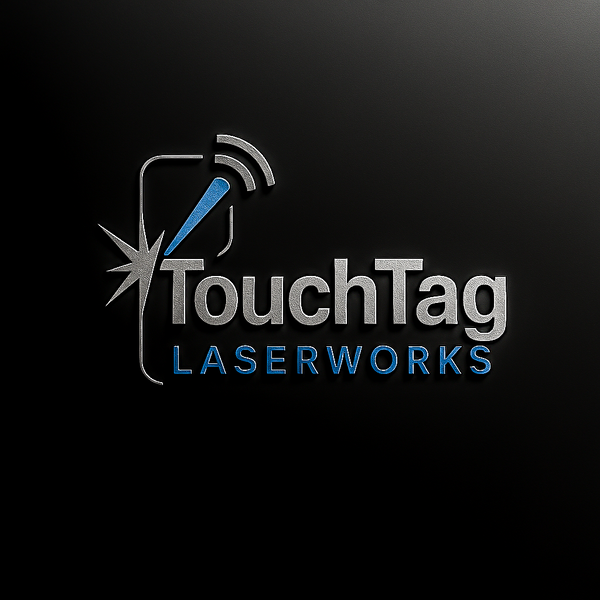Laser Safety 101: Why Using the Right Materials Matters
Share
At TouchTag LaserWorks, precision and quality are our top priorities—but nothing is more important than safety. When it comes to laser engraving, choosing the right material is not just about getting the best result; it’s a critical matter of health and safety for everyone involved.
You might be surprised to learn that certain materials, when hit with a powerful laser, can release invisible, toxic fumes that are extremely dangerous. This is why we have strict protocols for every project that comes into our shop.
Here’s a look at why we’re so particular about the materials we work with and what you should always avoid in a laser engraving environment.
1. The Hidden Danger: Toxic Fumes and By-products
When a high-energy laser beam cuts or engraves a material, it essentially vaporizes it. The resulting smoke and dust contain tiny particles and gasses that can be hazardous.
Polyvinyl Chloride (PVC): The Absolute No-Go
This is the most critical material to avoid. When PVC is laser cut or engraved, it releases chlorine gas, which is highly toxic.
- For the machine: Chlorine gas immediately creates hydrochloric acid when it mixes with moisture in the air. This highly corrosive acid can quickly destroy the optics, mirrors, and metal components of an expensive laser machine.
- For the operator & environment: More importantly, it is extremely dangerous to inhale, causing severe respiratory issues and permanent damage. We will never process PVC.
Plastics to Be Wary Of
Other plastics can also produce harmful by-products. For instance, some materials, like ABS, can melt rather than vaporize, creating a messy result and thick, noxious smoke that must be properly ventilated. Other plastics may contain flame retardants that release toxic bromine compounds when burned.
2. Combustion Risk: The Threat of Fire
While lasers are designed to cut and engrave, any concentrated heat source carries a risk of combustion. Certain materials are far more flammable than others, especially when they are thin or have a high oil/resin content.
- Oily or Resinous Woods: Woods like pine are beautiful, but they have a higher sap and resin content, which can increase the risk of an internal fire starting in the cutting path. We manage this by using specific settings, but it highlights why constant supervision is non-negotiable.
- Highly Flammable Foams & Fabrics: Materials like certain foams (e.g., polystyrene) and thin fabrics can ignite very easily. We must use low power and high-speed settings—and keep a fire extinguisher close at hand.
3. Material Integrity and Safety Assurance
To ensure a safe and successful engraving experience, we adhere to a strict materials policy.
| Safe & Preferred Materials | Materials We Handle with Extreme Care | NEVER Process |
| Wood: Plywood, MDF, Maple, Cherry, Walnut | Coated Metals: Must be laser-safe powder coating. | PVC (Polyvinyl Chloride) |
| Acrylic: Cast and Extruded | Leather: Only vegetable-tanned or non-chrome tanned. | Vinyl, Faux Leather (unless certified safe) |
| Glass & Ceramic | Plastics: ABS, HDPE (often results in a messy finish/fumes) | Carbon Fiber/Fiberglass |
| Anodized Aluminium | Styrofoam/Polystyrene | Teflon/PTFE |
| Safe Rubber Stamps | Beryllium Oxide |
4. Our Commitment to Your Safety and Quality
As professional laser engravers, we have invested in a high-quality system that includes:
- Industrial-Grade Ventilation: A powerful exhaust system that actively pulls all fumes and smoke out of the engraving area, with filtration that exceeds industry standards.
- Material Sourcing Knowledge: We only source and recommend materials with verified safety data sheets (SDS) or materials that we know from experience are safe to process.
- Operator Training: Our team is trained to recognize hazardous materials and to immediately stop work if a material's behaviour indicates an unexpected or dangerous chemical reaction.
If you are providing your own materials, we will always ask detailed questions to verify the composition. If a material cannot be definitively confirmed as safe (e.g., an old piece of scrap plastic with no label), we reserve the right to decline the project.
It’s our promise to you that we will prioritize the health of our team and the integrity of our equipment over a single job. By being responsible about materials, we ensure that your final product is not only beautiful but also created in a safe, clean environment.
Have a question about a material for your next project? Don't hesitate to reach out! We’re happy to guide you toward the safest and highest-quality options.
Ready to start your safe, custom project?
